( Log In ) Log In is for TREC Teachers & Researchers only
  |
| Dena_Rosenberger |
 Dec 4 2005, 10:03 PM Dec 4 2005, 10:03 PM
Post
#1
|
 TREC Teacher    Group: TREC Team Posts: 96 Joined: 1-November 05 Member No.: 22 |
Getting to Know an Ice Core
4 December, 2005 (The internet was down yesterday so I was unable to post) For those interested in things Antarctic, check out the weekly Antarctic newspaper at http://AntarcticSun.usap.gov Hello from the Ice! For additional Antarctic pics, check out the Gallery. Where’s Rosenberger? Pony Lake, Ross Island, Antarctica Thanks to all of my friends and family who helped me get to this astounding continent! Yesterday we headed for Pony Lake again to collect more cores. They need as many cores as they can get to process for Dissolved Organic Matter analysis. I did not go with them last time to core, so this will be my first coring experience. And boy, was I in for an experience! I didn’t realize how well I would get to know an ice core. As we approached Mt. Erebus on the way to Pony Lake, the radio was giving off a constant stream of chatter from the teams up on the volcano. It seems that this active volcano is having some temper tantrums and spitting out volcanic rocks, or “bombs” from one of its lava lakes in the crater. One of the scientists said that he wasn’t happy about it and they were going to go back down the volcano, and the approaching pilot said that he wasn’t happy about it either. There is a live video feed in the common room outside of our lab from the Erebus rim-cam and it is fascinating to watch. > Mt. Erebus is acting up: 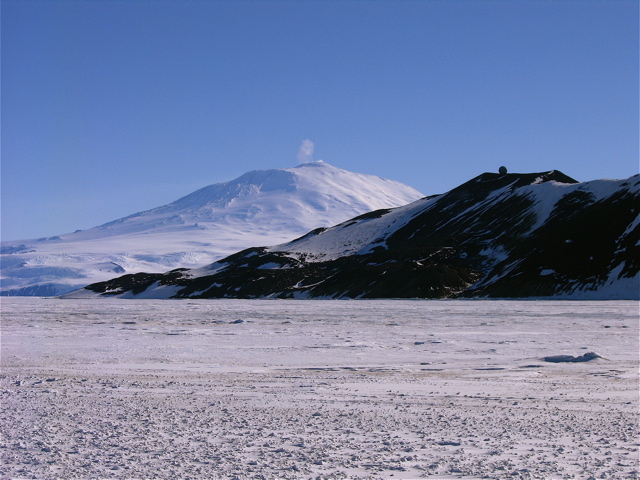 The sea ice that we travel across is really starting its break-up as the summer here approaches. McMurdo Station moved the Ice Runway where I landed, which is on the sea ice, over to the other side of Ross Island onto the Ross Ice Shelf, a much thicker slab of permanent ice. Pisten Bully drivers are being very careful about crossing over the cracks on the sea ice. The rule says that the ice must be at least 30 inches thick and the crack width less than a third of the tread length. At the big crack near the Barnes Glacier, the ice is still almost a meter thick and the crack is not very wide, with seawater bubbling up through it. Still, it is a bit disconcerting to drive over. A group of “Kiwis” or New Zealanders caught up to us here in their Haggaland transporters so we profiled the crack together. There is one major difference between these transporters and the Pisten Bully. Haggalands float. The Kiwis cross the ice crack:  When we got to Pony Lake, we grabbed the coolers for the ice cores and headed over the ridge to the lake. I stopped to take pictures of a crack that is forming along the boundary between the land here and the sea ice. A black flag means a possible dangerous area, take precautions. 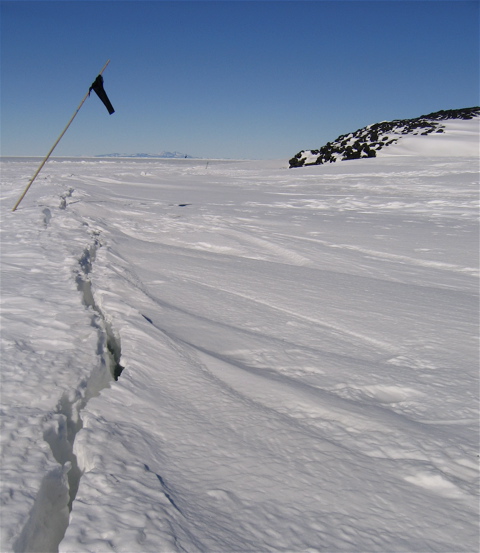 While I lay on the ground taking pictures along the crack, a large black form crossed in front of my viewfinder. I jumped up in surprise to find two Adelie penguins scooting along the ice toward me on their stomachs. I’ve never seen them on this side of the ridge! We hung out for awhile and they discussed the large red Pisten Bully and how to get back over the ridge to the lake. Then I excused myself to run and catch up with the rest of the team. Where the heck are we?:  Let's go...  Well, the wall I built to keep the snow out of our pit worked a bit too well in the last storm. A huge sand dune-like drift had formed behind the wall and all the way into the pit, filling it almost completely. > The monster snow drift:  Unfortunately, it is NOT nice, soft fluffy snow, but hard crusted pack snow that would have to be cut into blocks again. We are giving up on the pit as it has actually now added to the depth of snow on the lake. The wind blew so hard it carved and evaporated the ice blocks in the wall into fantastical shapes. 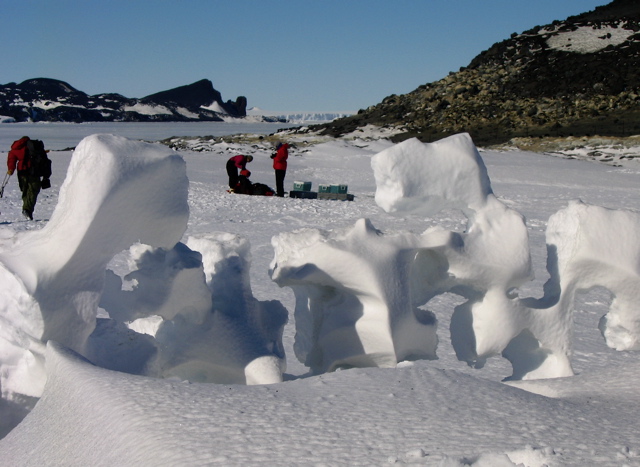 The wind was not blowing too hard today, so we decided to core from the green patch of ice closer to the rookery. Remember that we can’t use any power tools, so all of the coring must be done by human power. And it certainly takes power. Although it was a good workout, I think my arms and back will be sore for a few days. When hand coring, you must first push down hard on the corer to get it to “bite” into the surface of the ice as you begin to turn it with the handles. Then, you turn it down into the ice, a half turn at a time. Chris demonstrates the half twist:  It is approximately a meter long and 4 inches in diameter. If the blades are sharp, it goes fairly easy. If not, you have to change them out. Once it is down, you attach an extender bar to the top and continue. When you feel the bottom of the lake, the core is ready to be pulled out. > Halfway there:  Now you must do a squat, hook your arms under the handles of the corer, and pull up as hard as you can to bring up the core. Hopefully, it doesn’t slide out as you pull, because then you have to reach down the core hole and try to grab it. And oh yeah, it really stinks, too. You can smell the malodorous gases rise up when you get down to the layer of bacteria and algae that have been fermenting all winter. I’ve never smelled anything quite like it. And oh yeah, the green muck gets all over your clothes as you try to get the core into a long thin plastic bag to take back to the lab. 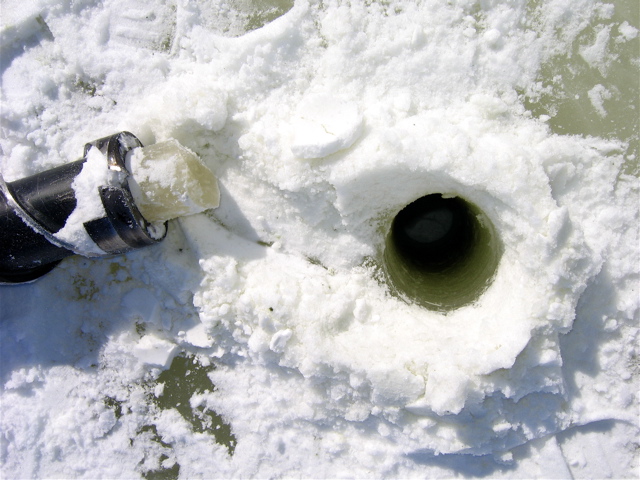 > A view down the ice hole:  Chris had brought along some high-powered satellite-connected GPS equipment and will map out the lakeshore as best as he can, estimating where it is under all of the snow. 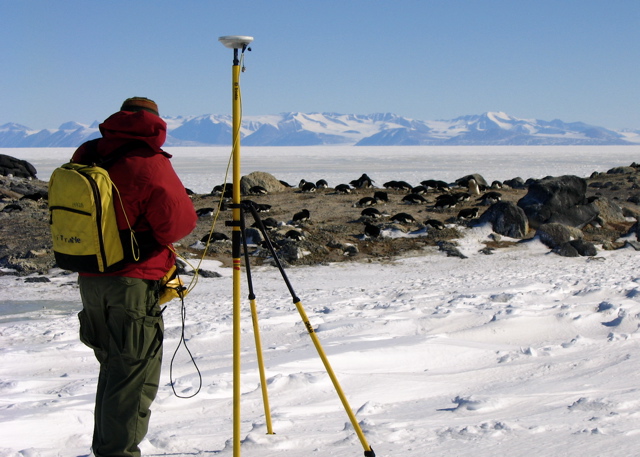 The Adelie penguins in this rookery, about 2000 nesting pairs, walk approximately 70 kilometers (how many miles is that? A 10 K race is about 6.2 miles) to get to this rookery. Most of the females have now gone back to the ocean to catch fish, leaving the males to guard the eggs until they return. There were a lot of penguins walking around and coming over to see what we were doing, so we are not sure why they aren’t sitting on the nests. Perhaps they have lost their eggs to the skuas already and don’t have anything to do. Many of them came down to the fresh snow and rolled around and “splashed” in it and scooped it up with their beaks, looking like regular birds in a birdbath. It was pretty cute. The person in the background is an Adelie penguin researcher: 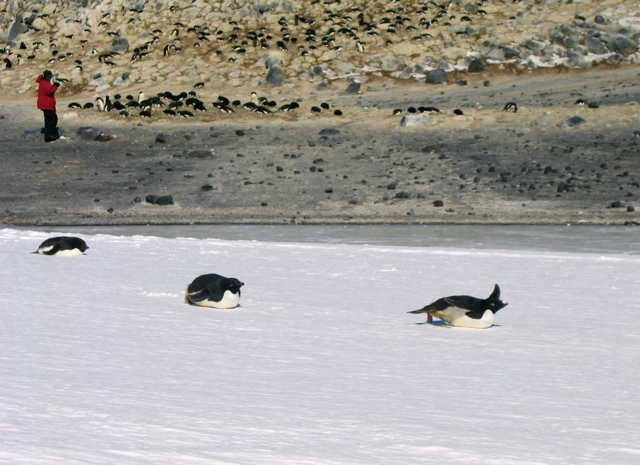 Can you spot the Skua? 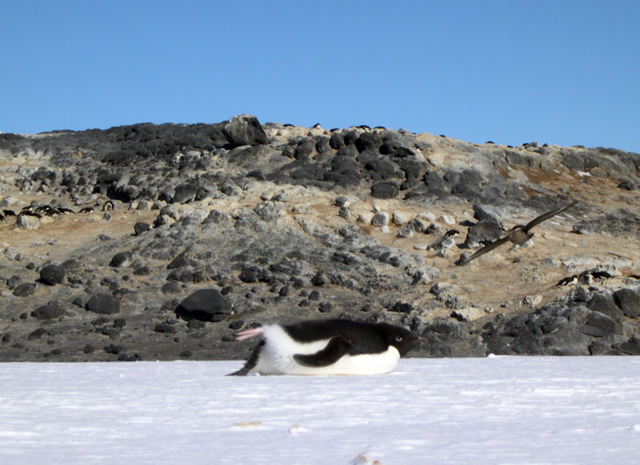 > Comparing a Skua to an Adelie: 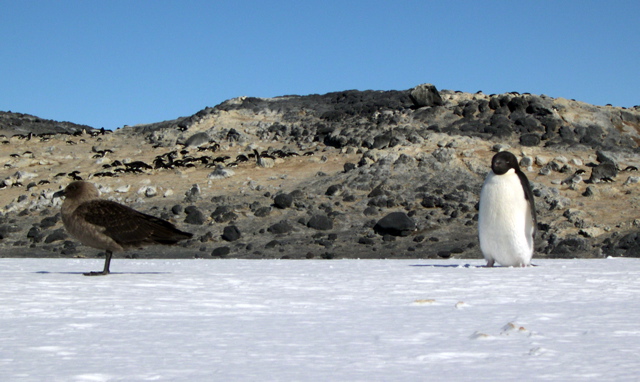 Parting shot: Everywhere that we had walked across the snow the last time we were here had a very interesting pattern on it. It took me a few minutes to figure out what was going on. Apparently, each time we had set a foot down, it compacted the snow under the boot enough so that the snow there was harder than the surrounding snow. When the high winds came through during the storm, the harder snow under the footprint resisted blowing away, leaving a snow footstep about 6 inches higher than the snow around it. Really bizarre looking! 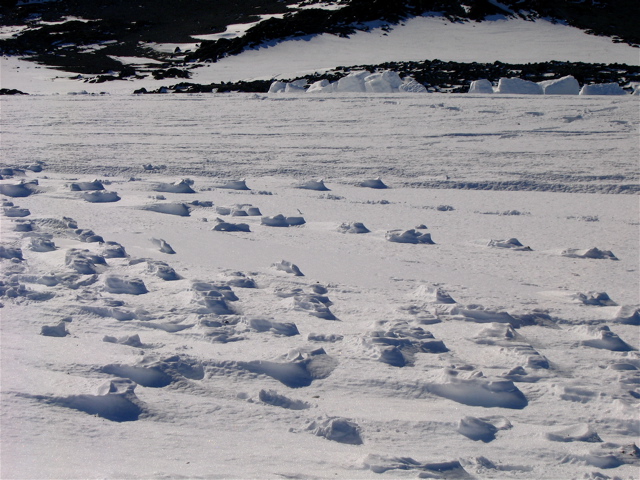 Did you know? The lowest temperature ever recorded on Earth’s surface was -89.6 C (-129.1 F) at Russia’s Vostok Station in Antarctica on July 21, 1983 (mid-winter). The highest temperature recorded in Antarctica was +15 C (To convert to Fahrenheit, F = [(9/5)C + 32]). Current Conditions at McMurdo Station Very nice conditions today but with pretty strong winds. For those of you from Southern California, it is kind of like a Santa Ana wind only about 100 degrees colder. Another storm system may move in Tuesday. Right now: Wind out of the southeast at 12-18 knots Clear, some high clouds Pressure: 29.595 inHg Temperature: 27 oF/ -3 oC with wind chill: 9 F/-13 C Sunset: February 20 at 1:38 am |
| Diana from Crest |
 Dec 5 2005, 05:24 AM Dec 5 2005, 05:24 AM
Post
#2
|
|
Unregistered |
Been walking, but still no joy on my knee problem. Very frustrating.....
Starting to get down in the 40s - which would be warm for you. I see one of the guys in the photos didn't have gloves on when he was coring the ice. I'm thinking about getting up early and going to the gym before work - we'll see how that goes. Probably go to the 24 hr on Midway near work. Looks like you're having fun We're suppose to be going to June Mt week of Xmas - but no snow yet. Guess we'll be boarding on dirt Other than that - sos. I'm sure the cats are happy being indoors, esp since it's getting to be winter. Still have Quattro - and what's left of my couch. Went to the deposition for the Allstate lawsuit - that was brutal. I did a lot of "I don't recall" - asking me things from 2 yrs ago when I can hardly remember what the heck happened yesterday Talk to you soon |
| Megan Blakey |
 Dec 5 2005, 05:41 AM Dec 5 2005, 05:41 AM
Post
#3
|
|
Unregistered |
Ha ms. cheeseburger! those footprints were pretty sweet. my mom goes "do you think it would be fun to do that?" and i said "heck yes it would be" and she goes "no way! you'd freeze your butt off!" im like w/e! ha ha! hope you are having a flippin sweet time! dont forget not to sweat!
|
| Guest |
 Dec 13 2005, 09:56 PM Dec 13 2005, 09:56 PM
Post
#4
|
|
Unregistered |
QUOTE(Dena_Rosenberger @ Dec 4 2005, 10:03 PM) Getting to Know an Ice Core 4 December, 2005 (The internet was down yesterday so I was unable to post) For those interested in things Antarctic, check out the weekly Antarctic newspaper at http://AntarcticSun.usap.gov Hello from the Ice! For additional Antarctic pics, check out the Gallery. Where’s Rosenberger? Pony Lake, Ross Island, Antarctica Thanks to all of my friends and family who helped me get to this astounding continent! Yesterday we headed for Pony Lake again to collect more cores. They need as many cores as they can get to process for Dissolved Organic Matter analysis. I did not go with them last time to core, so this will be my first coring experience. And boy, was I in for an experience! I didn’t realize how well I would get to know an ice core. As we approached Mt. Erebus on the way to Pony Lake, the radio was giving off a constant stream of chatter from the teams up on the volcano. It seems that this active volcano is having some temper tantrums and spitting out volcanic rocks, or “bombs” from one of its lava lakes in the crater. One of the scientists said that he wasn’t happy about it and they were going to go back down the volcano, and the approaching pilot said that he wasn’t happy about it either. There is a live video feed in the common room outside of our lab from the Erebus rim-cam and it is fascinating to watch. > Mt. Erebus is acting up:  The sea ice that we travel across is really starting its break-up as the summer here approaches. McMurdo Station moved the Ice Runway where I landed, which is on the sea ice, over to the other side of Ross Island onto the Ross Ice Shelf, a much thicker slab of permanent ice. Pisten Bully drivers are being very careful about crossing over the cracks on the sea ice. The rule says that the ice must be at least 30 inches thick and the crack width less than a third of the tread length. At the big crack near the Barnes Glacier, the ice is still almost a meter thick and the crack is not very wide, with seawater bubbling up through it. Still, it is a bit disconcerting to drive over. A group of “Kiwis” or New Zealanders caught up to us here in their Haggaland transporters so we profiled the crack together. There is one major difference between these transporters and the Pisten Bully. Haggalands float. The Kiwis cross the ice crack:  When we got to Pony Lake, we grabbed the coolers for the ice cores and headed over the ridge to the lake. I stopped to take pictures of a crack that is forming along the boundary between the land here and the sea ice. A black flag means a possible dangerous area, take precautions.  While I lay on the ground taking pictures along the crack, a large black form crossed in front of my viewfinder. I jumped up in surprise to find two Adelie penguins scooting along the ice toward me on their stomachs. I’ve never seen them on this side of the ridge! We hung out for awhile and they discussed the large red Pisten Bully and how to get back over the ridge to the lake. Then I excused myself to run and catch up with the rest of the team. Where the heck are we?:  Let's go...  Well, the wall I built to keep the snow out of our pit worked a bit too well in the last storm. A huge sand dune-like drift had formed behind the wall and all the way into the pit, filling it almost completely. > The monster snow drift:  Unfortunately, it is NOT nice, soft fluffy snow, but hard crusted pack snow that would have to be cut into blocks again. We are giving up on the pit as it has actually now added to the depth of snow on the lake. The wind blew so hard it carved and evaporated the ice blocks in the wall into fantastical shapes.  The wind was not blowing too hard today, so we decided to core from the green patch of ice closer to the rookery. Remember that we can’t use any power tools, so all of the coring must be done by human power. And it certainly takes power. Although it was a good workout, I think my arms and back will be sore for a few days. When hand coring, you must first push down hard on the corer to get it to “bite” into the surface of the ice as you begin to turn it with the handles. Then, you turn it down into the ice, a half turn at a time. Chris demonstrates the half twist:  It is approximately a meter long and 4 inches in diameter. If the blades are sharp, it goes fairly easy. If not, you have to change them out. Once it is down, you attach an extender bar to the top and continue. When you feel the bottom of the lake, the core is ready to be pulled out. > Halfway there:  Now you must do a squat, hook your arms under the handles of the corer, and pull up as hard as you can to bring up the core. Hopefully, it doesn’t slide out as you pull, because then you have to reach down the core hole and try to grab it. And oh yeah, it really stinks, too. You can smell the malodorous gases rise up when you get down to the layer of bacteria and algae that have been fermenting all winter. I’ve never smelled anything quite like it. And oh yeah, the green muck gets all over your clothes as you try to get the core into a long thin plastic bag to take back to the lab.  > A view down the ice hole:  Chris had brought along some high-powered satellite-connected GPS equipment and will map out the lakeshore as best as he can, estimating where it is under all of the snow.  The Adelie penguins in this rookery, about 2000 nesting pairs, walk approximately 70 kilometers (how many miles is that? A 10 K race is about 6.2 miles) to get to this rookery. Most of the females have now gone back to the ocean to catch fish, leaving the males to guard the eggs until they return. There were a lot of penguins walking around and coming over to see what we were doing, so we are not sure why they aren’t sitting on the nests. Perhaps they have lost their eggs to the skuas already and don’t have anything to do. Many of them came down to the fresh snow and rolled around and “splashed” in it and scooped it up with their beaks, looking like regular birds in a birdbath. It was pretty cute. The person in the background is an Adelie penguin researcher:  Can you spot the Skua?  > Comparing a Skua to an Adelie:  Parting shot: Everywhere that we had walked across the snow the last time we were here had a very interesting pattern on it. It took me a few minutes to figure out what was going on. Apparently, each time we had set a foot down, it compacted the snow under the boot enough so that the snow there was harder than the surrounding snow. When the high winds came through during the storm, the harder snow under the footprint resisted blowing away, leaving a snow footstep about 6 inches higher than the snow around it. Really bizarre looking!  Did you know? The lowest temperature ever recorded on Earth’s surface was -89.6 C (-129.1 F) at Russia’s Vostok Station in Antarctica on July 21, 1983 (mid-winter). The highest temperature recorded in Antarctica was +15 C (To convert to Fahrenheit, F = [(9/5)C + 32]). Current Conditions at McMurdo Station Very nice conditions today but with pretty strong winds. For those of you from Southern California, it is kind of like a Santa Ana wind only about 100 degrees colder. Another storm system may move in Tuesday. Right now: Wind out of the southeast at 12-18 knots Clear, some high clouds Pressure: 29.595 inHg Temperature: 27 oF/ -3 oC with wind chill: 9 F/-13 C Sunset: February 20 at 1:38 am |
| David Youngblood |
 Dec 18 2005, 05:14 PM Dec 18 2005, 05:14 PM
Post
#5
|
|
Unregistered |
Thank you for the erosion pictures and the comparison of the skua to the penguin. The warmer weather after a storm seems to bring everyone's interest up.
|
| Guest |
 Dec 19 2005, 04:29 PM Dec 19 2005, 04:29 PM
Post
#6
|
|
Unregistered |
I bet Wally would love to hike up the volcano and fined some select rocks...neat shots
|
  |
1 User(s) are reading this topic (1 Guests and 0 Anonymous Users)
0 Members:

|
NSF Acknowledgment & Disclaimer | Time is now: 2nd November 2024 - 02:18 AM |
Invision Power Board
v2.1.7 © 2024 IPS, Inc.









